The peaks of Lobuche, Imja Tse, and Mera offer a world class mountaineering classroom for students on an IWLS Nepal Mountaineering Course. You’ll set fixed lines, learn about high altitude medicine, and attempt to summit these incredible mountains.
Course Photos
-
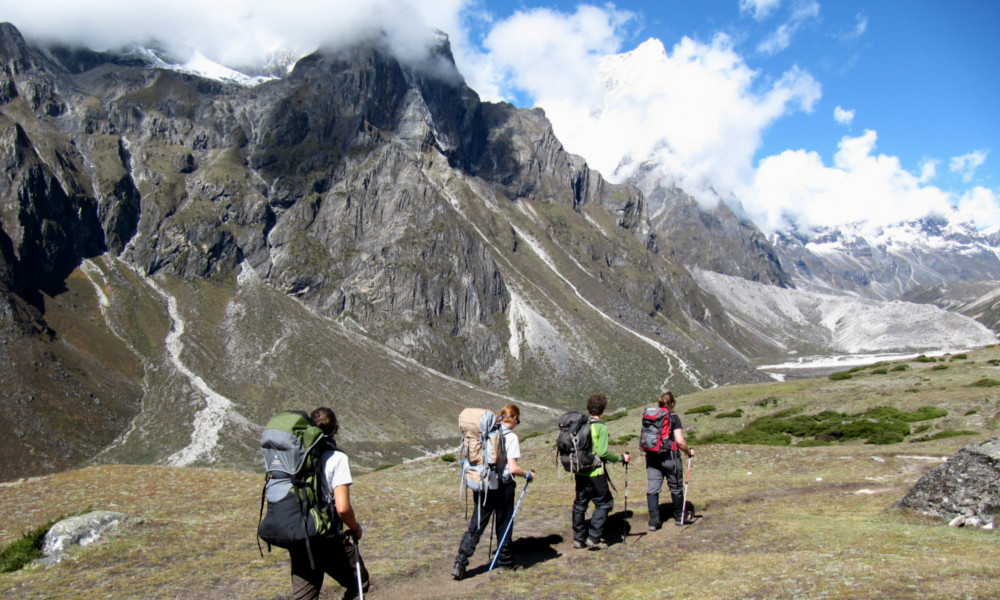
 Nepal offers incredible scenery, high altitude climbing, and a rich culture
Nepal offers incredible scenery, high altitude climbing, and a rich culture
-
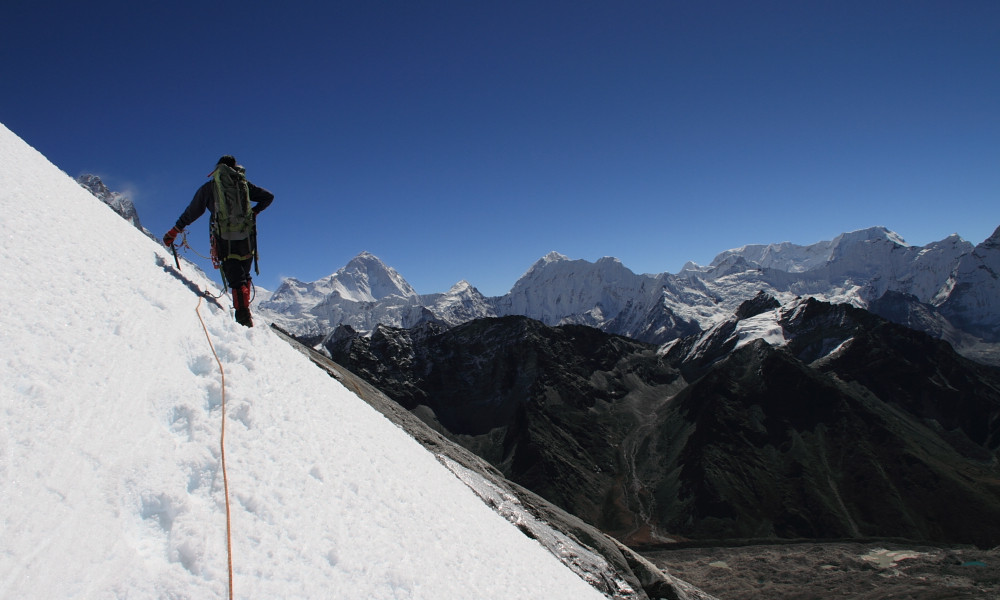
 High on Island Peak, Nepal
High on Island Peak, Nepal
-
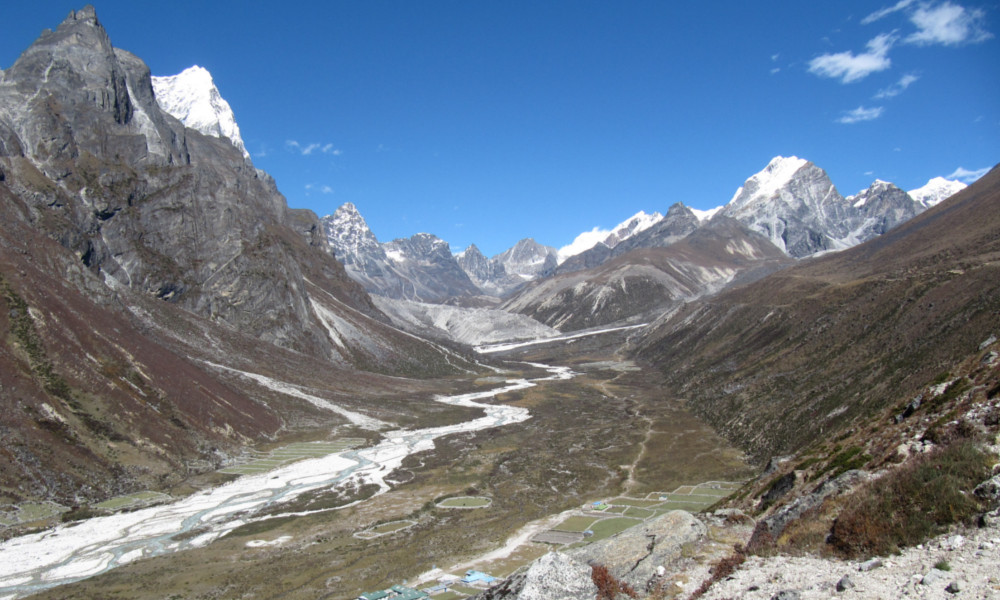
 Group enroute to polish ice climbing and crevasse rescue skills
Group enroute to polish ice climbing and crevasse rescue skills
-
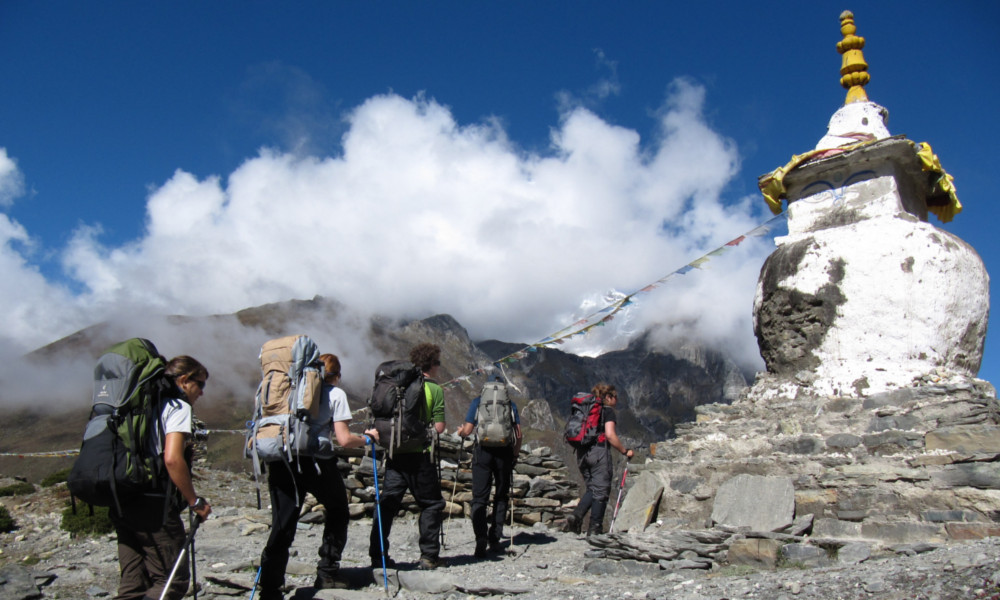
 Beautiful Stupa and other culturally significant sites are abundant along the route
Beautiful Stupa and other culturally significant sites are abundant along the route
-
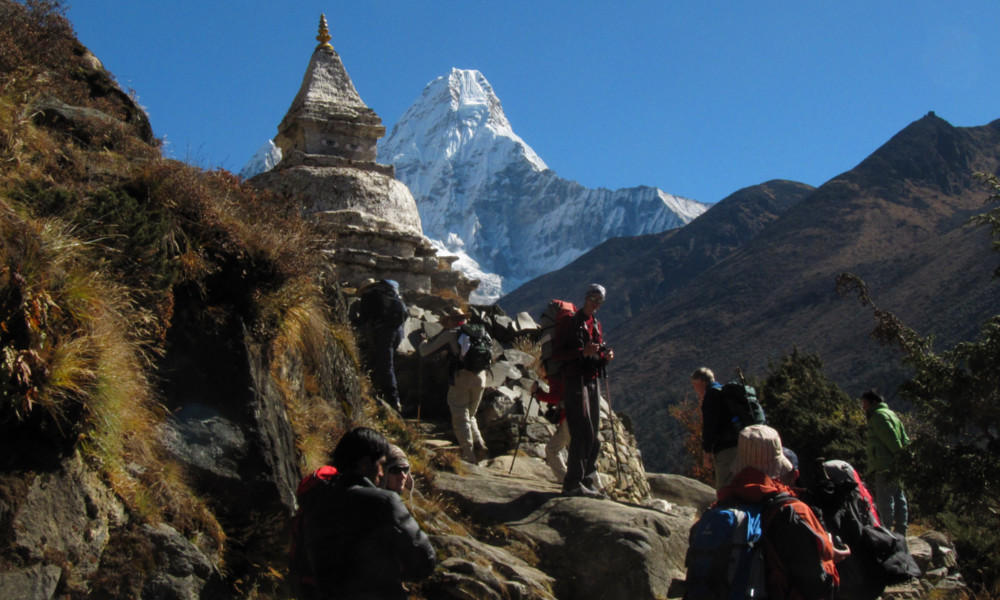
 Ama Dablam towers above during the trek towards the upper Khumbu.
Ama Dablam towers above during the trek towards the upper Khumbu.
-
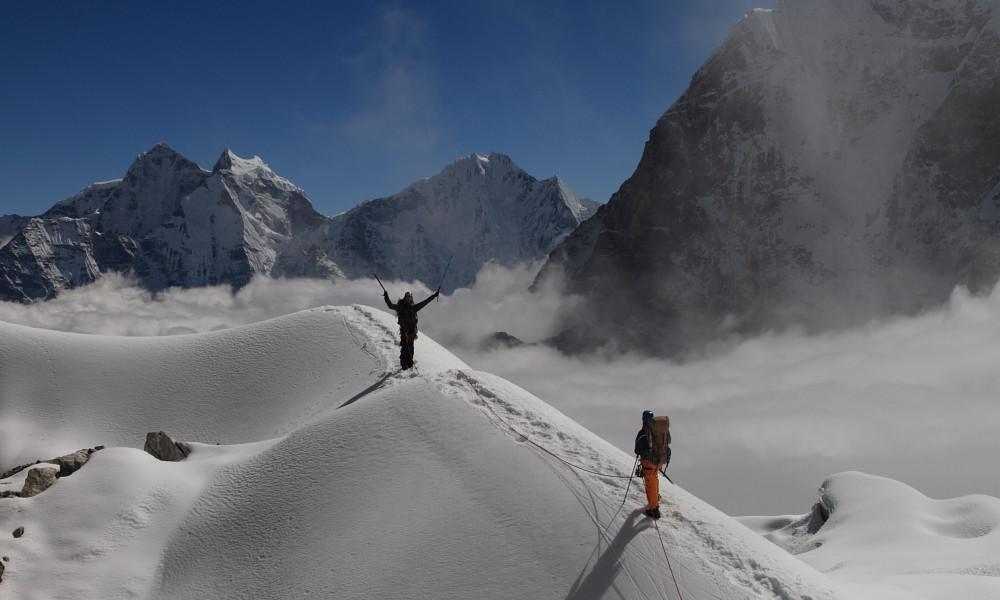
 High on Lobuche, students taste the thin air close to 20,000'
High on Lobuche, students taste the thin air close to 20,000'
-
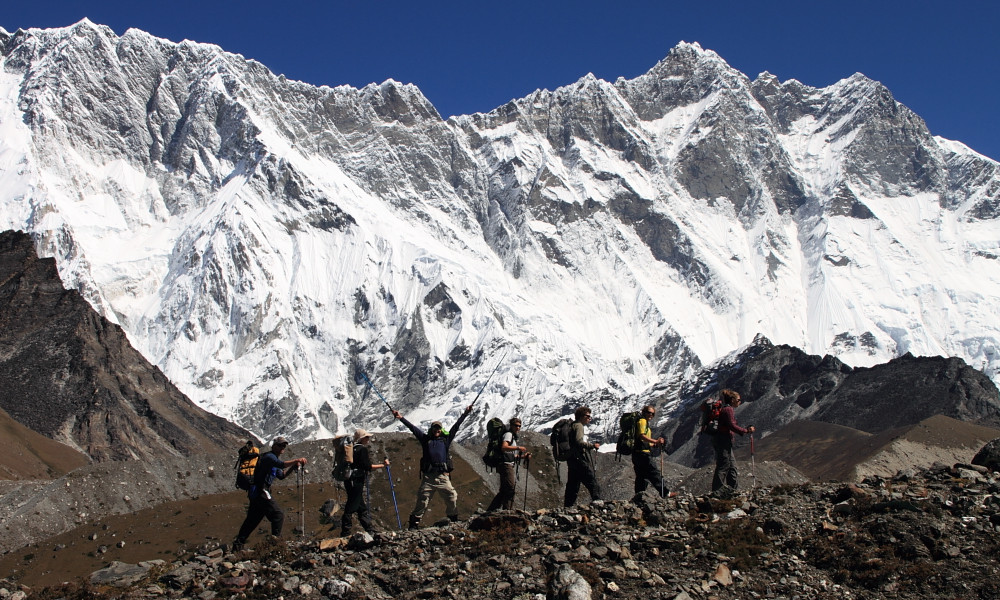

-
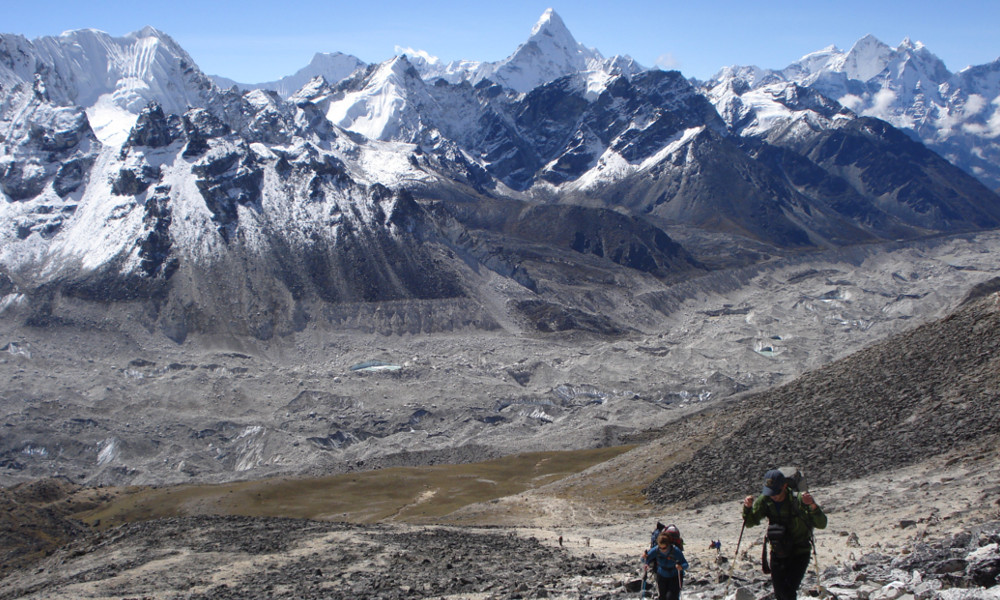
 Our Nepal program is a mix of trekking, climbing, and expedition logistics.
Our Nepal program is a mix of trekking, climbing, and expedition logistics.
-

 Ascending Lobuche East
Ascending Lobuche East
-
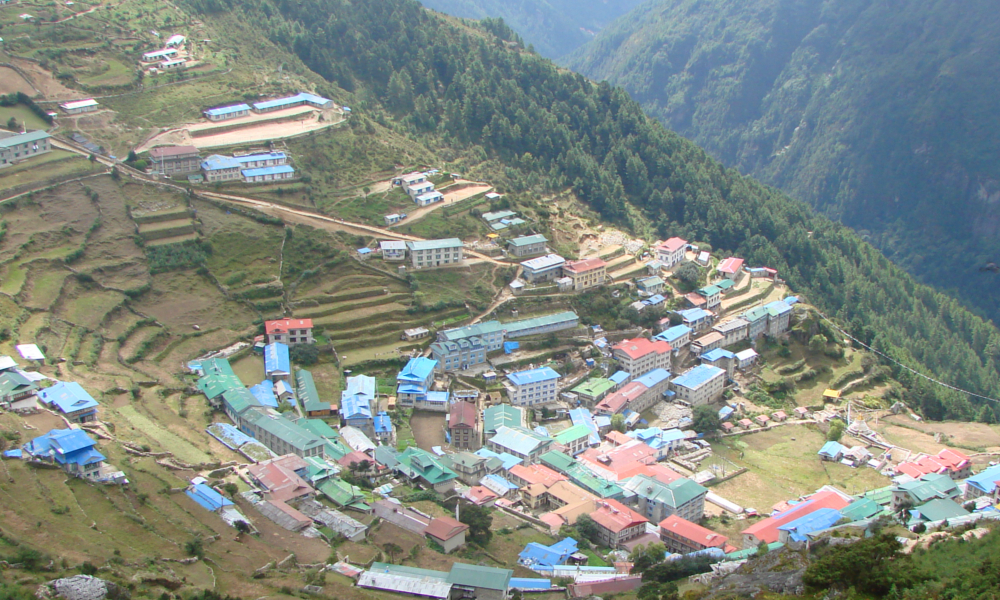
 Namche during the trek into Island Peak basecamp
Namche during the trek into Island Peak basecamp
Course Notes
Meeting Point: Kathmandu, Nepal
Destination: Himalayan Range - Island Peak, Mera Peak & Lobuche East
Duration: 40 days
Price: $8250 (+ tax, in USD)
Activity Type: Mountaineering
Season: September, October, November
Technical Skills: Navigation, snow travel, ice safety, avalanche safety, international travel, rope skills
Leadership Skills: Group management, LNT, inter-cultural relations, pacing
Difficulty Level: 4 out of 5
Paperwork Required: Registration, Health Form, Land Based Activity Waiver
Valid passports required
CLICK HERE FOR DATES & PRICES
Course Description
Climb and hike among the Himalayan peaks - a mountaineer's dream! Imagine ascending into the upper Khumbu, painted with the backdrop of Mt. Everest, Lhotse, and Ama Dablam. This mountain range has inspired mountaineers like few other places.
Our classroom will be set among the clouds, in glacially-ringed valleys, and alongside Sherpa villages. The peaks of Lobuche (20,075 ft/6,119 m) Imja Tse or Island Peak (20,285 ft/6,183 m) and Mera Peak (21,247 ft/6,476 m) will serve as our blackboards. On an IWLS Nepal Mountaineering course, you’ll set fixed lines, learn about high altitude medicine, and attempt to summit these incredible peaks.
We'll learn hard skills, travel into beautiful places, and experience the Sherpa culture firsthand. Between setting a high camp, reviewing crevasse rescue skills and teaching your peers about the rest step, you’ll enjoy the company of the friendly Sherpa people and learn about their culture. The IWLS Nepal Mountaineering course is perfect for students who want to develop high altitude mountaineering skills, international expedition experience, and leadership ability in a world class setting.
Nepal: Draped along the spine of the Himalayas, Nepal is a land of spectacular scenery, ancient Buddhist monasteries, and some of the best trekking, mountaineering, and river rafting on earth. Tumultuous rivers fill glaciated valleys, ancient trails meander below towering 8000 meter peaks, and rural villages dot the landscape. IWLS courses offer a chance to experience the incredible Sherpa culture, trek through the awesome panorama of the Himalayas and climb among the tallest peaks of the world while learning expedition and leadership skills.
Kathmandu: Kathmandu, the capitol of Nepal, is the starting and ending point for our mountaineering course. It is a unique blend of cultures and time periods; students will have time before and after the course to explore this city. While in Kathmandu, we will visit the Hindu and Buddhist temples of Syhumbunath, Bodanath, and Pashupatinath, as well as the historic Durbar Square.
Namche Bazaar: This historic trading hub is the staging point for nearly all of the summit attempts on Everest. The market itself sells everything from trinkets and artifacts to climbing equipment. It's still home to the Sherpa and Tibetan cultures, tradition, and hospitable lifestyle.
Himalayas: This great mountain range has inspired climbers for thousands of years. The Himalayas include the highest peaks in the world; over 100 are more than 24,000 ft (7,300 m) above sea level.
Mt. Everest: Known as Chomolungma in Tibetan, Qomolangma Feng in Chinese, and Sagarmatha in Nepali, the highest point of our world (at 29,035 ft/8,850 m) is located in our classroom. Along our journey, we will catch a glimpse of where the sky meets the earth, and see the peak that inspired mountaineers for centuries.
Sherpas: We will trek through the heart of the Sherpa culture, and experience it in full along the way! From traditional tea houses, to food, to meeting them in person, we will immerse ourselves into the Sherpa way of life as we explore their homeland.
Our Instructors: IWLS instructors and guides are highly-trained professionals recognized as some of the best in their field. They have a wealth of experience from guiding throughout Nepal, Alaska, Canada, and the world. They genuinely enjoy sharing their knowledge of the outdoors in the wild places that they love. Their experiences and leadership help our students to have the best possible experience during their course. Students' safety, education, and enjoyment are their primary goals. The International Wilderness Leadership Schools’ educational model nurtures leadership development and creates an awareness of the guiding mentality that is essential for leading safe, fun adventures in the mountains. The combination of technical skills training, experiential education and practical leadership experience make the IWLS curriculum world-class.
Experience Level: No previous experience is necessary.
Certifications: Upon completion of the course, participants may qualify for the following certifications:
 Guide Training Certificate of Completion
Guide Training Certificate of Completion
Course Itinerary (printable PDF)
Day 0: Arrive in Kathmandu.
Day 1: We’ll spend the first day preparing, planning, having a pre-trip meeting, and packing food and equipment for our expedition into the Khumbu region. We talk about expectations for the course from the students and from the instructors.
Day 2: The drive from Kathmandu to Jiri takes about nine hours. We’ll stay overnight at a lodge in Jiri.
Day 3: We’ll start our trek from Jiri to Deurali, about 6 hours.
Day 4: Deurali to Sete, about 5 hours.
Day 5: Sete to Junbeshi takes about six hour and we cross over the Lamjura Pass (11,480ft/3500m).
Day 6: Junbeshi to Nunthala.
Day 7: Nunthala to Bupsa.
Day 8: Bupsa to Surkey takes about five and a half hours. At the start of the day, we ascend steeply for two hours to climb over Khari La Pass (9450ft/2880m.) Surkey is a small Sherpa village at the bottom of Lukla.
Day 9: Surkey to Phakding takes about five hours.
Day 10: Phakding to Namche Bazaar: This is a big day, hiking ancient trails, crossing suspension bridges, and climbing to Namche Bazaar at 11,300 feet. Namche is the cultural center of the Khumbu. Home for the weekly market where traders from the lowlands trade with the highland Sherpa people. We will spend 2 nights in Namche exploring and acclimatizing.
Day 11-12: Namche to Tengpoche Monastery: Tengpoche is the largest and most active monastery in the Khumbu. We will spend 2 days here for further acclimatization. We will do a variety of side hikes. The Tengpoche monastery is the religious center of the Khumbu. Many of the Sherpa people’s most important religious festivals and ceremonies occur here. We will likely spend another day here acclimatizing and taking in the incredible views of Thamserku, Kangtaga, Ama Dablam, and Mt Everest.
Day 12-14: Tengpoche to Pheriche: We’ll spend 2 days there for even more acclimatization, and a visit to the Himalayan Rescue Association in Pheriche.
Day 15-16: Pheriche to Chukung.
Day 17: Rest day in Chukung.
Day 18: Ascent of Chukung Ri (18,253 ft/5565 m). This acclimation ascent offers incredible views of the Nuptse-Lhotse wall (the largest rock wall in the Himalaya), the pink granite monolith of Makalu, and the southern wall fluted with ice gullies from Baruntse (7000 m) and Ama Dablam (7000 m).
Day 19: Move to base camp of Island Peak.
Day 20-24: Establish high camp and summit Imja Tse (20,285 ft/6,183 m). We will summit via the south ridge or the east face, depending on conditions. We’ll also have additional opportunities to learn mountaineering skills.
Day 25: Move camp to below peaks of Lobuche.
Day 26-30: The peaks of Lobuche (20,07 5ft/6,119 m) provide great options for covering mountaineering skills. We’ll make an attempt on Lobuche East.
Day 31: Phakding to Surkey.
Day 32: Surkey to Bupsa (7708 ft/2350 m) via Phuiyan.
Day 33: Bupsa to Nunthala (7216 ft/2200 m).
Day 34: Nunthala to Junbeshi (8770 ft/2675 m).
Day 35: Junbeshi to Sete.
Day 36: Sete to Deurali (8872 ft/2705 m).
Day 37: Deurali to Jiri (6250 ft/1905 m).
Day 38: Return to Kathmandu.
Day 39: Extra acclimatization and/or weather day.
Day 40: Debrief and flights home.
A Typical Day
While water is heating, you will most likely be preparing for the days’ adventures. You will play an integral part of the expedition team by setting up camp, cooking meals, or carrying a portion of the group gear. You may be leader of the day, responsible for planning the day’s trek, accomplishing objectives, or facilitating a lesson plan.
The day’s activities will vary depending on weather, location, and progression of the course. We may work on developing your technical mountaineering skills set, learn about different leadership styles, or get an alpine start on a nearby peak. Regardless of the day’s activities, it will be full of learning and adventure. Dinner could be anything from tasty traditional Nepali fare to noodles; students often walk away from our courses with a newfound love for cooking and for international cuisine.
The day will finish with a debrief session where we’ll discuss the day's events, what you learned, and how you’ll be able to use your newfound skills in the near future.
The IWLS General Curriculum outlines the essential components for effective outdoor leadership. Here are a few points that your course will focus on:
- Leadership: We not only exemplify leadership – we teach it and implement it. Students will have opportunities to lead the group through a variety of activities, objectives, and responsibilities.
- Safety and Risk Management: Safety is always our #1 consideration. As the course progresses, students will develop an awareness to appropriately assess risk and make safe decisions in and out of the field.
- Expedition Behavior and Group Dynamics: Because this course is a true wilderness expedition, interactions between group members need to be supportive and contribute to the efficacy of the group. The daily dynamics of the group, combined with guided instruction, will teach students not only how to be a member of a cohesive team, but how to influence and lead an expedition.
- Environmental Ethics: As adventurers in some of the most pristine environments on the planet, it is our duty to respect the natural world. All of our courses practice and teach Leave No Trace® principles.
- Communication Skills: Speaking in public, managing a personal conflict, or leading a group in the wilderness - all of these situations require effective communication. Students will gain confidence in their communication abilities while developing personal leadership styles during this course.
- Decision Making and Problem Solving: Over the course of the semester, we’ll discover ways to assess problems, explore solutions and evaluate options in order to make effective and safe decisions in the field.
- Wilderness Emergency Procedures and Treatment: Learn how to effectively manage safe, efficient and timely backcountry rescues.
- Natural and Cultural History: Having a strong understanding of cultural history, flora, and fauna is an integral part of leading people in an outdoor environment. You’ll learn some of the botany, ecology, and geology that apply to these remarkable areas.
- Teaching: You’ll have the opportunity to develop lesson plans, teach in front of the group, and learn the importance of progressions for teaching technical skills and leadership.
The IWLS Mountaineering Curriculum is built from countless expeditions in Alaska and around the world. You’ll learn how to be a competent and proficient mountaineer in a variety of different environments. Below are some topics we’ll cover:
- Self Arrest: What happens if you fall on a steep now slope? Learn, through hands on experience, how to stop a fall quickly and efficiently.
- Anchors: Anchor building is a fun, yet intricate subject. We’ll examine single, double, triple and complex anchors, and their different applications. Learn how to place anchors in snow, rock, and ice.
- Belaying: Should we use a fixed belay or a running belay? Our team will learn and practice the finer points of different belay techniques such as the hip belay, running belay, boot axe belay, fixed belay, and more!
- Ascending: Fixed lines are an important tool for large groups and guiding applications. We’ll learn how to efficiently use, build and maintain them.
- Rappelling: Rappelling down a steep rock face is a thrilling moment and our team will learn how to do it safely. We’ll also look at different methods for teaching rappelling and dealing with incapacitated climbers.
- Rope Teams: Learn the appropriate applications for the figure 8, water knot, double fisherman, bowline, and other essential climbing knots.
- Knots: Rope team travel is a complicated endeavor that requires skill, technique and teamwork. We’ll cover everything from prussik arrangement to team management.
- Crevasse Rescue: Traveling in glaciated terrain requires that every member of the team be proficient in crevasse rescue. We’ll learn how to get a team mate out of a crevasse quickly and efficiently.
- Objective Hazards: Rock fall, river crossings, and avalanches are examples of objective hazards. Learn how to identify such hazards and minimize group exposure.
- Subjective Hazards: Among other things, dehydration, fatigue and personal pride can be detrimental to group safety. Learn how to implement measures to mitigate these potential hazards.
- Technical Climbing: Rock climbing, ice climbing, and steep snow climbing are all included in the IWLS curriculum.
- Timing: In the mountains, timing is everything: when to leave camp, when to turn around, and when to push for the summit. Time management is a critical component of safe travel and plays into many aspects of mountaineering.
The IWLS Backpacking Curriculum prepares students for exploration into remote, backcountry settings.
- Backpacks: Proper packing and fitting of backpacks improves efficiency and helps avoid injury.
- Tents: Staying dry in the wilderness is an essential survival skill. You’ll learn how to repair a damaged tent, how to set up camp in high winds, and techniques to secure your dry space for the night.
- Stoves and Campfires: The ability to repair a broken stove, make an emergency fire after being submerged in an icy river, and melt snow efficiently for water are key components for leading a group in the wilderness.
- Cooking: Sometimes in the backcountry, the meal makes the day. Whether cooking oatmeal or Thanksgiving dinner, you’ll develop your skills at making tasty treats.
- Lightning Hazards: Learn how to read weather patterns and avoid exposure, and how to manage a group in an emergency situation.
- River and Stream Crossings: In river crossings, attention to detail and safety are #1. You’ll learn and practice safe techniques for wading across a small stream or doing a Tyrolean traverse across a raging river.
- Travel on Scree and Talus: Learn how to safely travel on this potentially dangerous terrain.
- Geology: From plate tectonics to granitic batholiths, you’ll learn the history of the land you are exploring and how these forces create and influence the environment around you.
Course Documents:
- Course Overview- Printable detailed course overview & itinerary.
- Equipment List - Overview of personal clothing and equipment that you'll need for this course.
- Rental Gear List - List of gear and personal items available for rent
- Registration Form - Outlines policies, and essential information. One required per participant.
- Health Form - This form enables our guides to have accurate health information in the event of an emergency.
- Land Based Activity Waiver - One required per participant. Guests under the age of 18 may go on one form.
- Nepal Travel Info - Information on travelling to Nepal.
What is included in the course price:
- Food & Lodging during the course - We will provide group camping gear and all meals during the course.
- Transportation during trip - Travel to the trail and back to Kathmandu.
- Professional instructors - Our instructors and guides have extensive knowledge of the area, and a passion for climbing and trekking in wild places.
Students are responsible for the following:
- Personal clothing & Equipment - Review the equipment list included under "Documents."
- Food & Lodging outside of the course - Students are responsible for food and lodging before and after the course.
- Travel insurance - We require travel insurance for all of our international programs.
- Airfare - Review the "Travel Information" under "Documents" for more details.
- Reviewing course policies - Please reference our policies page for policies regarding payment, cancellations, refunds and student responsibilities.
- Gratuities.
To Book your adventure, follow the steps below:
- Please call to confirm availability at 1-800-766-3396 or fill out an online form to request more information:
- Place a deposit of $500 or 25% of trip cost (whichever is less) to reserve your spot: this can be place over the phone by credit card, check in the mail, or through our payment gateway.
- Once you've reserved your spot, you'll receive a welcome packet with all the necessary registration forms and trip information.
- Be sure to submit all trip registration documents at least 45 days prior to your course. This includes information on your arrival/departure, lodging, dietary, and medical information.
 
Feel free to call or email anytime if you have questions about your upcoming trip. Our team is excited to help you prepare for your adventure!
Student Comments:
Nepal has been a dream of mine for years, and I couldn't have asked for a better way to see it. Robbie was a great instructor, and taught me how to climb in the most beautiful place on earth! - Elliot F.
